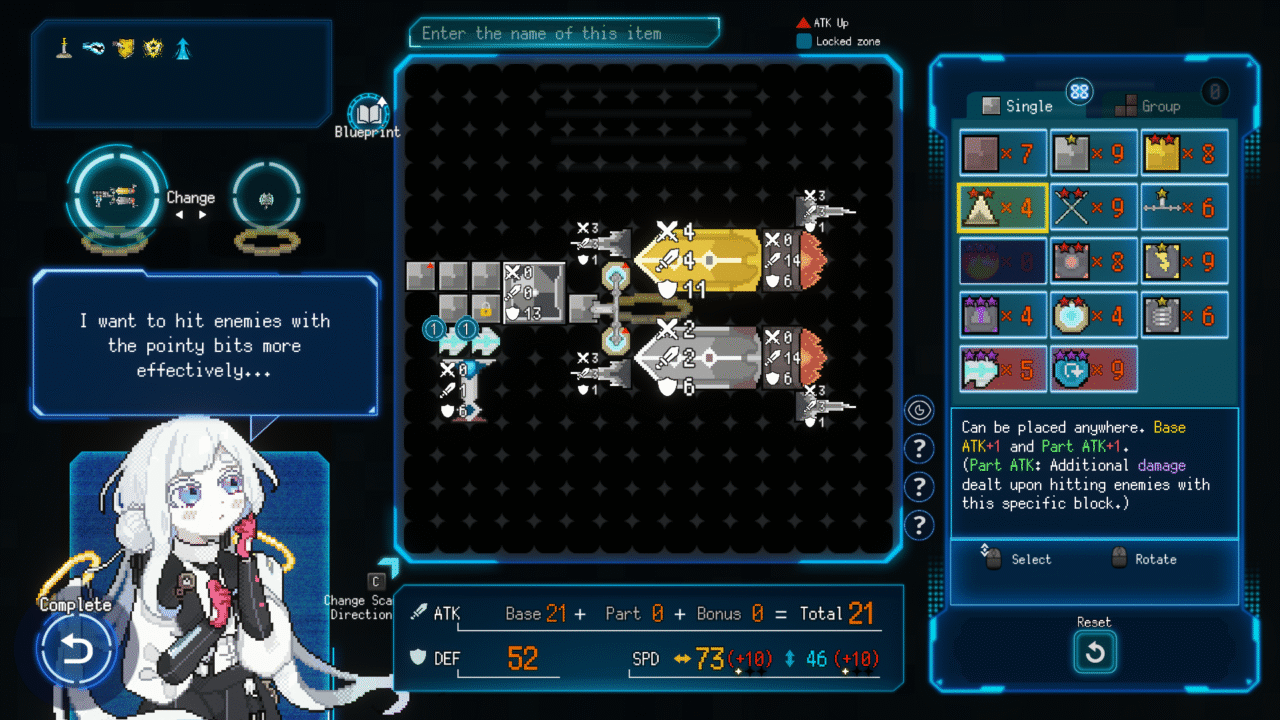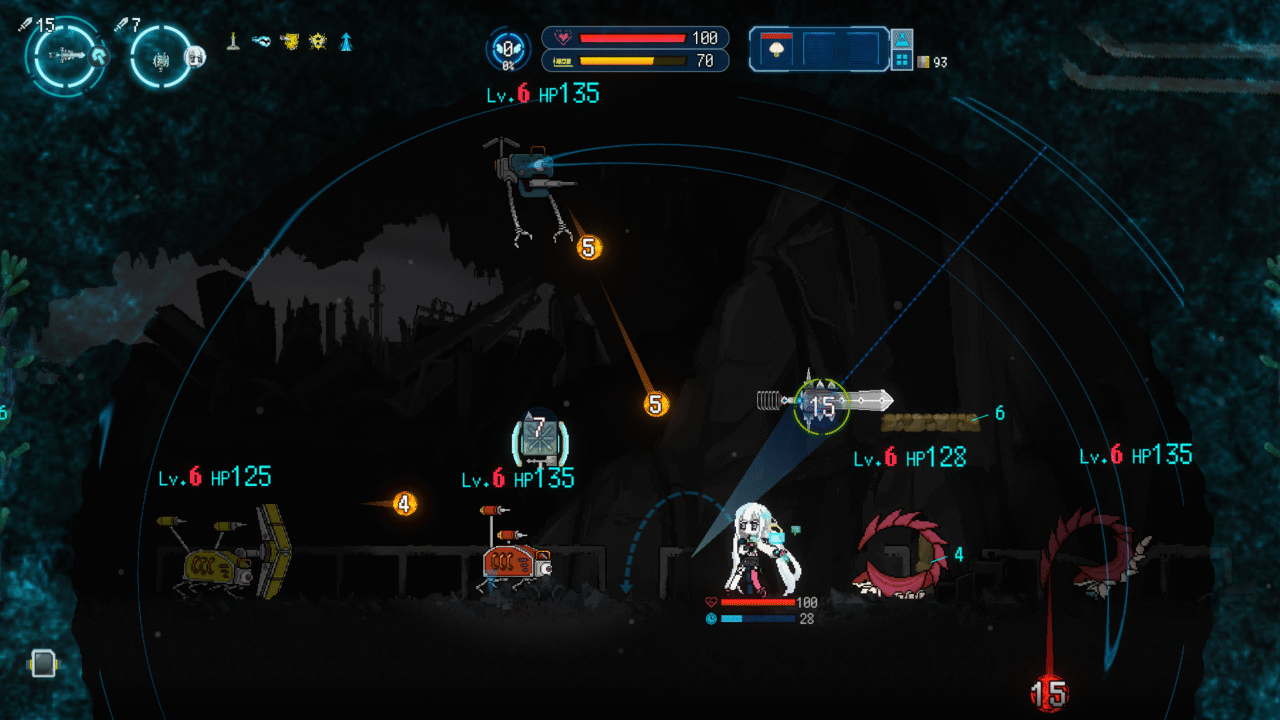Every still frame of Million Depth sort of convinced me that this game was a side-scrolling action game in the vein of Castlevania, but how you kill the monsters of the depths in this game bears no resemblance to it. Every floor you fall to is a stage that could hold one of the various shops to trade at, an opportunity to scope out the remains of human society, and more. Many have the potential for monsters (you’ll know before you go thanks to the rogue-like “choose your own adventure” style of dungeon progression). When you find some, your get trapped in a sort of fish tank of combat, where enemies lash out at you between walls that shrink as time passes and they are slain. You dodge their attacks, which only move towards you while you actively move yourself, and strike back, either by charging bad guys with a dash attack, or by ramming a hovering weapon into them.
You can, and must, customize this weapon every run, giving it shape and function depending on the pieces you use. A jagged tree branch of a structure made of bronze blocks can do some damage, with every point adding some attack value to the entire piece. Maybe you add spikes to the ends of the gnarls to up the pokey potential, or you can use recipes for specialty parts, jamming two spikes on top of each other to make a longer, deadly one, or stacking two rows of blocks together to create a self-swinging sword blade. I was really surprised by how much I got into making implements of death, Gummy Ship-style.
 How you make these weapons determine how they’re best used. Whatever side the scariest point is what baddies will be most in danger, and because you can’t rotate these weapons around, the weakest side is likely where you’re most vulnerable. You do eventually get multiple objects that you can switch between and build for a balance of offense and defense – a floating shield to block incoming damage and a long spear-like thing to stab back, for instance. Or you can lean into madness, and turn them both into weapons of war. On one run, I had a pair of simple blocks with spikes on opposite sides so that they could bounce enemies between them like a sadistic pinball machine. Just as surprising as the lure of creating these weapons, and the combat mechanics themselves, was just how many times I put together some weird set of pieces that turned into a goofy yet not completely out of line strategy. I did wish the screen didn’t always feel so busy between all of the monsters, you and your weapons and UI tool tips galore. The latter being a problem that persists into all of the menus as well, as menus aren’t just crowded but sort of a mess to navigate.
How you make these weapons determine how they’re best used. Whatever side the scariest point is what baddies will be most in danger, and because you can’t rotate these weapons around, the weakest side is likely where you’re most vulnerable. You do eventually get multiple objects that you can switch between and build for a balance of offense and defense – a floating shield to block incoming damage and a long spear-like thing to stab back, for instance. Or you can lean into madness, and turn them both into weapons of war. On one run, I had a pair of simple blocks with spikes on opposite sides so that they could bounce enemies between them like a sadistic pinball machine. Just as surprising as the lure of creating these weapons, and the combat mechanics themselves, was just how many times I put together some weird set of pieces that turned into a goofy yet not completely out of line strategy. I did wish the screen didn’t always feel so busy between all of the monsters, you and your weapons and UI tool tips galore. The latter being a problem that persists into all of the menus as well, as menus aren’t just crowded but sort of a mess to navigate.
I wish the story contained the same little “wows” but I came away from Million Depth’s tale the same way I walked into it, largely not impressed. I’m willing to hedge my early lack of investment on my general malaise towards twee anime girls who’s adorable earnestness must shine through the dark cloud of the impossible burden placed on their shoulders. I certainly don’t watch enough to be qualified to say that it’s true that every anime-inspired thing does this when it centers young women, but it certainly feels that way to me. There’s also that sinking feeling playing through to your first clear – traveling all the way to the millionth kilometer and into the Earth’s core – that you’ve seen this story and its coming twists before.
 It does, thankfully, pivot from that one particular nod, allowing for some expansion on a different twist that you can see falling down from a million kilometers away. But none of your journey to figure out what happened to all of the humans on Earth was particularly compelling from moment to moment. Stumbling across ancient ruins of school houses, survivors hiding under the stature of their God for protection, and even bizarre natural wonders like endless deserts or gardens where deep roots act as trees stands out the first time, but loses its luster on repeat visits. Its also all undermined by verbose and mediocre writing all around, full of internal monologues and back and forth between characters that overstay their welcome.
It does, thankfully, pivot from that one particular nod, allowing for some expansion on a different twist that you can see falling down from a million kilometers away. But none of your journey to figure out what happened to all of the humans on Earth was particularly compelling from moment to moment. Stumbling across ancient ruins of school houses, survivors hiding under the stature of their God for protection, and even bizarre natural wonders like endless deserts or gardens where deep roots act as trees stands out the first time, but loses its luster on repeat visits. Its also all undermined by verbose and mediocre writing all around, full of internal monologues and back and forth between characters that overstay their welcome.
It has an interesting format for how the rest of the game is organized beyond the first clear, though. Each subsequent play through exists to make progress towards a “true ending,” each floor you land on with some exploration elements often come with some sort of choice to make that can alter your path forward, and altering enough paths in enough ways will take you deeper into the narrative mystery being woven. There’s a literal flow chart to consult between runs to see if you interacted with the right things the right way to open new story corridors. A curious and tempting set of boxes to check, but the substance of all of this travel left a lot to be desired. Even though the tone of each of these new runs can vary dramatically, I found the more droll spaces between the real cool and compelling stuff to be too far to wade through. I haven’t found this true ending yet, and I’m not sure I will.
Million Depth is a game about subversion. It really wants you to think it’s going to do one thing, and will revel in the disarray caused when it does something unexpected. These zig zags didn’t make me gasp, but I did give curious “oh really” on a pair of occasions. Combat has a sneaky amount of depth in its unconventional and maybe overcooked design, and after an early-ish twist, the structure of getting to the beginning to the end of each dive down to the center of the earth changes completely. What it becomes though is a plodding exercise in check-listing that wears thin quickly, further dragged into the darkness by a story and characters cloaked in a mystery that is heavy on drama and light on intrigue.






